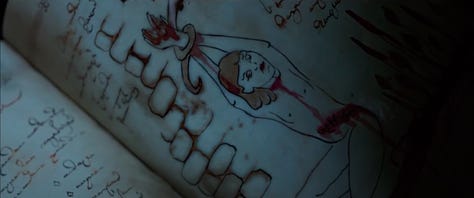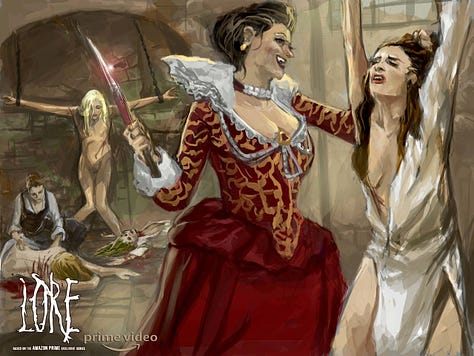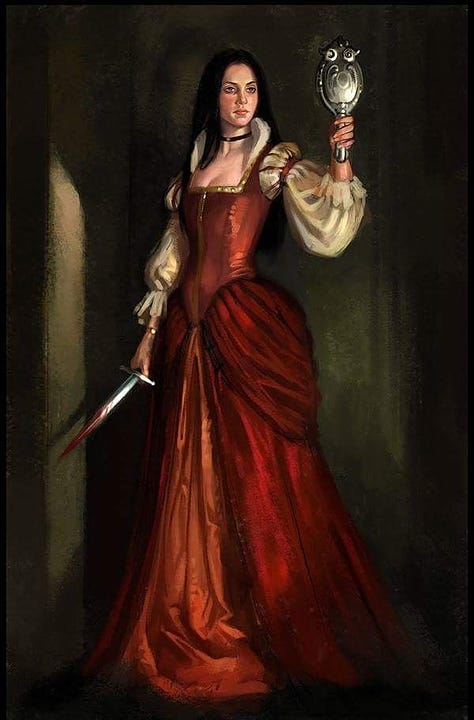
Discover more from Crime Culture Media
Elizabeth Báthory
The Blood Countess is controversial. There is a war between fact and fiction when it comes to her story. Much of what is known about her life is based on folklore and myth… or is it?
She is actually credited in the Guinness Book of Records as, “the woman who committed the highest number of murders. She is credited with 650 victims, although only 80 murders could be proven. There is a story that Countess Bathory was slandered by a political conspiracy.”
She was imprisoned after being convicted of multiple murders, but the main questions are, did commit these crimes alone, or at all?
Countess Elizabeth Báthory de Ecsed was a Hungarian noblewoman who was born in August of 1560 the same year that the first wooden pencil was invented.
During her childhood she grew up in Ecsed Castle and struggled with a number of issues as a child which were treated in bizarre ways. She suffered from what is now believed to be epilepsy which at the time was called, “falling sickness.” Her symptoms included near constant migraines, violent mood swings, and seizures. Her sickness was treated by, “rubbing the blood of someone who wasn't affected on her lips.” (Czech Center)
Other members of her family also suffered from this and it is understood that some of them were also mad and very violent. So this was a Bathory family trait, which could have been the result of inbreeding. She had a relative who was the Prince of Transylvania, who was known for being mentally unstable.
Growing up in a powerful Hungarian family, she witnesses violence by seeing how badly beaten mistreated some of the servants were. This was the norm. She was related to princes and to the King of Poland, and Bishops. Her family was described as “uncommonly cruel.” This says a lot, because at the time, cruelty was the norm from royalty. They were ordained by God and could get away with anything. Wars were also being fought throughout her entire life.
There is a story about a gypsy being tortured in a really graphic way, and Bathory saw this as a young girl. This person was tortured and then sewn into the body of a horse, and both were left out to rot and die. She was six years old when this happened.
In addition, war was ongoing between Hungary and the Ottomans the entire time she was alive, and she was exposed to a lot of violence.
Once Báthory reached the age of 13, she became engaged to 18-year-old Count Ferenc Nádasdy, though their marriage was arranged far before that. They had a number of children and the Budapest National Archives house person letters written by Bathory which show that she was a loving mother who cared deeply about her family.
One descendant of Bathory named Dennis Bathory-Kitsz said, “How was it possible that a Countess, a woman who spoke multiple languages, who wrote in multiple languages, who conducted negotiations with two empires, who had children that she loved and clearly care for could also be a person who could kill 600 or more of her servants. One at a time, by her own hand.”
In one documentary on Bathory describes her as the Paris Hilton of the time because she was so wealthy, and she family was so powerful that she could go out and do anything. She was known for being sexually promiscuous from a very young age and would go into town and pick people out who she wanted to sleep with.
One great influence in Báthory's life was her Aunt Clara who introduced her to witches and alchemists, which were super taboo, but who the hell is going to saying anything about it? Bathory knew from a young age that she could get away with almost anything. Her Aunt was also bisexual (some accounts say she was a lesbian).
Bathory was described as beautiful, with pale skin and raven black hair. At age 15 he married Ferenc Nádasdy. He was a handsome, incredibly rich warrior. He was 21 at the time. Apparently, they got along really well.
They moved to the Nádasdy Castle, where allegedly her new husband taught her the way of torture. He would give her gifts, which sounds romantic, but these gifts were, torture implements and in some cases the gift would be the opportunity to torture a person. ”He once gifted her spiked gloves that could be used on servants who made mistakes. For her amusement, Nádasdy restrained a young woman, who was then covered in honey and left to be devoured by insects.” (Czech Center)
The torture games got to be so bad that their local minister actually wrote a letter, which historians found, so this is solid evidence. This minister wrote a letter complaining about how bad the torture was. So for torture and brutality towards servants to be pretty typical at the time, it says a lot that someone was willing to speak up and write a letter condemning it.


While her husband was away she basically ran the family business, if you will, which included meeting with other nobles, and managing the estate which included 7 castles. She was described as a shrewd woman who had an unusually good grasp on military matters. She was an uncommon position for a woman at that time.
In 1604, Elizabeth's husband died, and she began to manage the Bathory family castle. Báthory's level of violence dramatically increased after she relocated to Čachtice Castle in the early 1600s, after her husband's death. She essentially had no supervision at this point and was incredibly wealthy. She was 44 years old when he died and it seemed like her mental health started to deteriorate. She was more sadistic and crueler to her servants.
Apparently, she was very hospitable to nobles who would come to visit her, but was known for having a very bad temper and her servants would often be targeted. She had a kind of fascination with young woman and would make her seamstresses work naked. She was also sexually sadistic and would torture her servant girls and burn their pubic hair with candles.
Her torture methods were very intense and are said to have included, “dismemberment, attacks of adult nature, needles, whips, and burning of the flesh.”
She would get very angry over little things, but she also enjoyed inflicting pain. One example is that if you didn’t iron her clothes properly, she would use that iron on your face and burn you with it. There is another example where a servant girl displeased Bathory and so Bathory jumped forward at the girl and ripped her jaw open with her own hands.
There are stories that she used very cruel torture on her victims like, “burning or injuring their hands, biting off the flesh off their face, hands, and other parts of off their bodies, and freezing or starving them to death.”
She would also take peasant girls as young as 12-years-old from the nearby town and bring them in to work for her or torture or to be her servants and then torture and kill them. Due to the stories that people were hearing about Bathory’s violence, local villagers were very fearful and would actually hide their daughters in an attempt to save them.
This was a big change from how peasants felt previously. If their daughter was taken to live in the castle and work for the countess, that would be a point of pride, but then their daughters stopped coming back home. People just never saw them again.
Rumors about the massacres of young girls didn’t just travel to the common folk of the surrounding town. Servants would all talk, and these stories began to reach the royal court, which would cause issues for Bathory down the road.
Bathory was obsessed with youth and beauty. One of the most popular beliefs or gossip, depending on who you ask, was that the countess would bathe in virginal blood as a way of preserving herself from aging - this is highly contested though. To get virginal blood, one must have living breathing virgins.
Apparently, this came about because one of her servant girls was brushing her hair, and she accidently brushed too hard and it like yanked Bathory’s hair. She yelled and turned around and bunched the girl so hard in the face that the girl’s nose bled, and it got on Bathory’s hand. Bathory noticed that the blood getting onto her had had a “rejuvenating effect.” That’s nonsense, of course, but from that point on Bathory believed strongly that blood would keep her looking young.
She is alleged to have killed more than 600 virgins in order to drink their blood and bathe in it, ostensibly she practiced vampirism on girls and young woman and would bathe in their blood to maintain soft skin and keep the wrinkles at bay since Botox and face lifts hadn’t been invented yet.
Graeme Murdock a 16th Century Historian said, “It’s clear that Elizabeth Bathory did have an unusual interest in blood. She seems to have enjoyed having her victims reduced to a sort of bloody state.”
Bathory had all kinds of ways of torturing people. There is a story of her having a cage that had spikes facing inward and she locked a girl in the cage and had it slowly close on her until she died. Bathory apparently liked the slow killings because she could enjoy her victims pain for longer.
She has been described as a vicious sexual sadist, who would bite into women and torture their private parts, and that many people were afraid of her. She was also believed to be bisexual, and was very attracted to woman and it made her want to hurt them.
She did have some help though; she had a little crew put together of three main servants. Two woman, one of whom was like a witchdoctor, and a man servant who had dwarfism (a little person).
There is another story of her taking servants outside in the winter and making them strip completely naked and she would have ice cold water thrown on them until they froze to death and stuck to the ground.
Historians say that she was completely mad, and that there was an element of experimentation to her crimes. She was able to get away with such heinous, brutal killings, that she started getting almost bored and would making up games and weird methods of torture to learn about how it might impact a human body.
Apparently though, she made a mistake. An investigation into her crimes began when she tortured a young noblewoman. Servants and peasants were one thing, nobody cared about them. Their pain was normal, and was frankly ignored, but to torture another noblewoman could cause a war.
Some people would be pushed over castle walls, some dumped out of carriages, some left in the river. It was really, very dark. There were only so many peasant girls available, and Bathory had killed so many girls, 17 per year on average. That she would dump bodies all around town. People were very afraid of her, and this is where she makes a mistake.
Bathory invited a noblewoman to her castle. This woman was a soprano, opera singer and Bathory wanted her to sing for her, but the woman was so afraid of Bathory that she just couldn’t sing well. Her nerves got the better of her and Bathory flew into a rage and killed her.
This victim was apparently not as high-class as Bathory was, but she still had royal blood in her veins and anyone who caused the death of a noble was to be punished.
In 1610, then King of Hungary, Matthias II, sent two men to investigate Bathory and collect evidence against her. They came back with dozens of eyewitness accounts that relay torture and death at the hands of Bathory.
The thing is the evidence against her was a lot of eyewitness accounts, but the eyewitnesses included the investigators who arrived at the castle and almost immediately stumbled upon the body of a young woman who had clearly been mutilated. Then they found another one, and another one, and another one. They found 9 in total, woman who were bitten and burned. It was awful. The two men were shocked because it was way worse than they thought it would be.
A big investigation opened into Bathory, which was rare for the time. Usually, nobles could really get away with anything. They interviewed around 270 people, some of them multiple times and according to one historian, “only about 4 of them said ‘I know nothing about this.’”
Apparently, the King wanted her to get a death sentence, but she had many influential acquaintances who were able to persuade him to give her a life sentence in her castle, in solitary confinement. So she wasn’t put on trial, she was never tried. Instead of being killed, she was imprisoned in that same castle where all of those horrific murders had occurred.
In essence, she was under hours arrest for the rest of her life. She could walk freely around her castle but could not leave.
Her servants were convicted of the murders, and they were tortured executed. This was done because they were all tortured and as a result, they confessed to the murders.
Four years after her arrest, in 1614, she passed away in her sleep at the age of 54. When she was buried in the town cemetery the villagers protested because of her crimes. It is believed her number of victims could have been as high as 600.
Her body was eventually moved to the Báthory family crypt back in her home in Ecsed.
It has been theorized that Countess Báthory was essentially set up by the King of Hungary. He was in debt to her, and for political reasons it would have been in his interest to eliminate her from court. To accomplish this, Bathory became a victim of rumors and conspiracy theories.
There is a theory that she did commit some crimes, but they were not these horrific acts of torture and brutality that they were made to be.
There is a statue of her in Cachtice square, which sits in front of the St Ladislav, the church she was buried in.
Pop Culture
Multiple movies have been made about Bathory and based on her crimes. In the 18th and 19th Centuries she gained the reputation for being like a vampire. The idea of vampires as creatures of the night were very popular at that time, and it just seems inevitable that with all the blood and gore and death surrounding Bathory that people would begin to whisper that she herself was a vampire, a female Dracula.
Most notably is Bathory: Countess of Blood (2008) is more historically accurate. It covers the war at the time, though the wig that she wears makes her hair like Napolean Bonepart’s hat.
It's giving Dora the Explorer get electrocuted.
The movie tells a story of a woman whose husband is gone at war for many, many years and she goes mad because she had this witch nurse hag lady as her chief adviser and she starts drinking potions with mushrooms, supposedly the psilocybin kind - shocking against the advice of her nurse witch - and she kills people and bathes in their blood but she's not like... torturing people. Well, maybe emotionally abusing people. Actually no, there's physical abuse, but it's not straight-up torture chamber styled.
The other movie is called The Blood Queen or Lady of Csejte (2015) depending on which version, and it is not historical. It's a horror drama movie, that focuses on two orphans who work in Bathory's castle and discover that she's been killing people. The actress playing the countess is blonde too, so they were even trying to make her look like Elizabeth Bathory, by all accounts.
I liked the movie, and there was this prop in it that got my blood going... sometimes I see things in movies, and it hits me "somebody in the art department spent a lot of time making that thing"
It was a book with drawings of her victims that looked like Patrick Bateman's work calendar, but from the 16th Century.



Also, she had better hair in this movie.
There is a wealth of “fan art” and AI rendered artwork of Bathory, much of which is highly sexualized.















We also discovered that McFarlane Toys makes a figurine of Bathory which is currently sold out.



Subscribe to Crime Culture Media
Crime Culture Media features articles, podcasts, and video documentaries about crime, media, and culture.


















